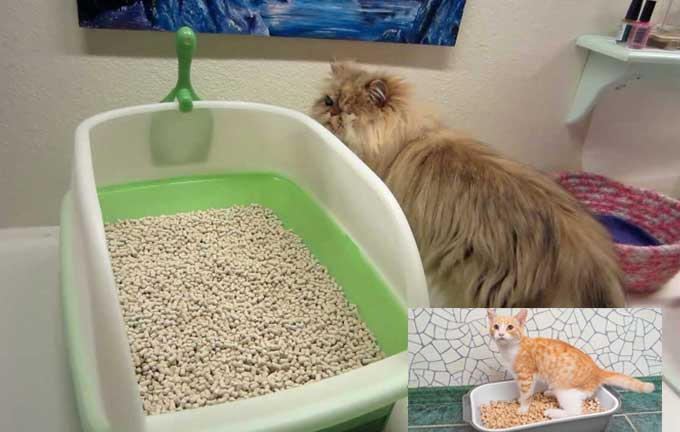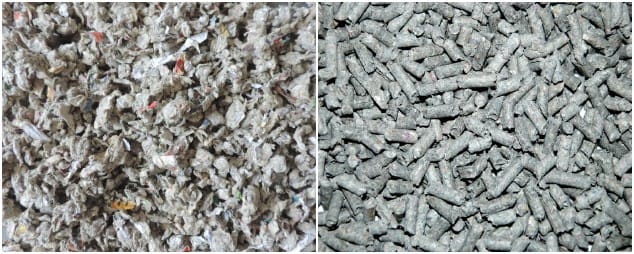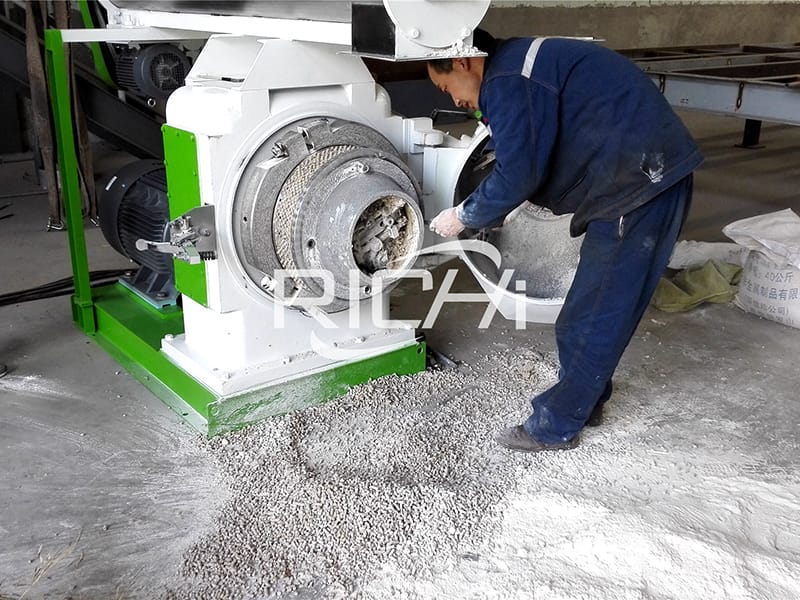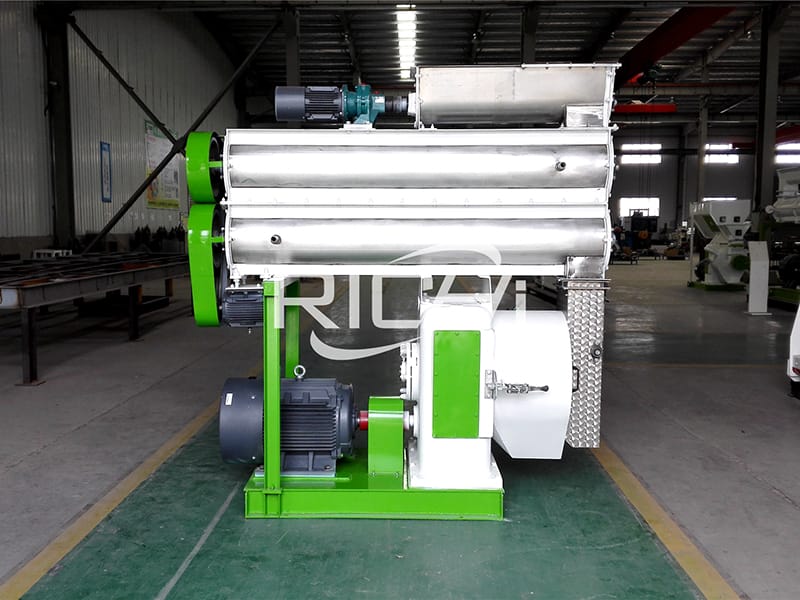1. Which is better? tofu cat litter pellet or bentonite cat litter pellet?
These two kinds of cat litter are good in clumping, water absorption and deodorization. It is difficult to say which kind of cat litter is better. It is better to take a look at the advantages and disadvantages of these two kinds of cat litter. It is also possible to make a choice later. Let's take a look at the advantages and disadvantages of bentonite cat litter and tofu cat litter.

(1) Advantages and disadvantages of bentonite cat litter pellets
Bentonite cat litter is also called condensed cat litter. It is the most commonly used cat litter. The water absorption of bentonite cat litter is good. It can completely absorb the moisture and urine in the feces and then condense into a big hard mass. The owner is convenient and hygienic when cleaning. Bentonite cat litter is not smelly if it is cleaned frequently, and the cat's foot feels better.
The disadvantage of bentonite cat litter is that the dust is relatively large. If it is left at home, a layer of white powder will cover the furniture after a long time, and the cat will cough and sneeze after smelling it. The particles of bentonite cat litter are relatively small, and it is easy to get stuck between the cat's toes, so it is not good for the cat to lick the cat litter.
(2) Advantages and disadvantages of tofu cat litter pellets
Tofu cat litter is made of tofu residue, which is environmentally friendly cat litter, so cat owners don't have to worry about the cat’s misingestion when using it. Tofu cat litter has clumping, water absorption and deodorizing properties. The above are all good, and the tofu cat litter is water-soluble, so the cat owner can directly pour the cat litter into the toilet after cleaning the cat litter, which is more convenient.
The disadvantage of tofu cat litter is that it tends to stick to the corners of the litter box during cleaning, and it requires the cat owner to clean it patiently. This is why some cat owners do not like tofu cat litter.
2.How to choose suitble cat litter?
Ever had a conversation about toilet paper with a friend? It can be a contentious one because we are all devoted to that one brand/colour/pattern. Well, it seems that can run in the family and just like we humans, some cat's will only use one type/brand and some cats couldn't give a rats behind!
The variety of substances that can be turned into cat litter is varied and growing. The most common types include clay (clumping and non-clumping), crystals, recycled paper, pine & other woods and grains. Cats are notoriously fussy and if owners find a litter that the cat happily uses, then it can be a real challenge to get Puss to change.
So how do you decide which one is right for you and your cat? Let's explore each type and how they work.
(1)Bentonite Products
Sodium Bentonite is a highly absorbent form of clay which clumps when moisture is added. The clumping action provides two benefits in that it tends to contain odours better and makes it easier to collect the waste affected clumps from the litter tray, leaving the untouched remainder in place for the next use. Some brands may give off small amounts of silica dust so cats with respiratory disorders may not be suited to these products. These products cannot be flushed and should be disposed of via normal household waste collection.
(2)Non-Clumping Clay Litters
These litters do not form clumps when the cats void but will still absorb urine which means that when you clean the litter tray, some affected pellets or pieces may remain if not doing a complete litter change. Fussy Cat Attapulgite litters are non-clumping and is a hydrated magnesium silicate made from Australia’s only commercial Attapulgite mine. Non-clumping clay litters generally require changing more frequently than clumping litters. As they are a mineral based product, they should not be flushed.
(3)Silica Crystal Litters
Made from solid granules of sodium silicate, the products tend to be highly absorbent due to an increased porosity. These litters are highly absorbent and control odours well so they tend to need to be changed less frequently than other products. Something to consider with silica crystal litters is that even though the smells and urine are trapped in the granules, by not changing the litter as frequently, bacteria does remain in place for longer periods? Some cats don't like the feel of crystals to walk on and may struggle to get used to that form of surface. Silica crystals should not be ingested and being a very fine substrate, it is important that cats who groom or lick their feet quickly after toileting, are not actually eating the litter after voiding. Silica crystal litters should be disposed of via the normal waste collection process.
(4)Biodegradable litters
These litters tend to be made from recycling products already in use, or using waste components from other products being manufactured so in themselves they become a useful part of the re-use of waste and good for the environment effort. Most of these litters can be flushed into the sewerage system but it is wiser to do this in smaller batches. Most of the biodegradable litters do need to be changed more frequently.
(5)Recycled Paper Litters
Paper litters come in a granule or pellet form and are made from recycled paper. These litters are very absorbent but do not form clumps to hold the urine within. The urine tends to sink down into the lower layers and you can change just the 'wet' part of the litter then top-up the tray. Paper litters are dust-free and biodegradable.
(6)Wood Based Products
Wood waste from other forms of manufacturing or processing are treated to remove any contaminants and then made into pellets, granules or raw pieces. The natural absorbency of wood draws urine into the material and may clump in a less traditional form. If the wood is very fine, the urine may create a sort of crumble sawdust material. Pine is a common wood used for these litters. Some wood products like Catlux includes a small percentage of Bentonite but are still flushable.
(7)Grain Based Products
The natural starches from grains are extracted and once soiled by urine, the product forms into natural clumps which can be collected and disposed of easily. Being a natural grain, usually corn or wheat, the litter is fully flushable. These products are generally very low in dust and provide a natural odour control. For cats who have any digestive issues or are allergic to grains, they may not be ideal as some ingestion may occur through grooming.

3.Selecting the right cat litter pellets
The key things that cat owners use when choosing which litter to buy are based on:
(1)Odour management: Cat litters do need to manage odours for the family and cat’s sakes. Cats are very clean in general and may refuse to use their litter trays if they are smelly.
(2)There are some mildly fragranced litters available that cats seem very happy to use but anything too highly scented may be rejected by the cat.
(3)Granule size: Some cats won't walk on the coarse, hard forms and others don’t like the fine, slippery versions. Bigger pellets or granules tend not to get stuck as easily in the cat's paws and finer granules should not be used for young kittens who can more easily inhale or ingest the product.
(4)Dust levels: Cats can track the fine dust from some products through the house and can also have their respiratory system irritated by litter dust, particularly when hooded litter trays are used.
(5)Environmental issues: Some owners will lean more towards highly sustainable raw products being the litter base or whether a product is biodegradable and safe for the environment in disposal.
(6)Cost: The purchase price of litters varies a lot and whilst some may be more expensive to buy, their efficiency at odour and waste management might make them a cheaper cost-in-use product.

4.Complete cat litter pellets manufacturing process
Cat litter made from wood, paper, grain, corncobs, citrus, and grass account for only 5% of today's market. The rest—about 95% of all cat litter—is clay based. Cat box fillers contain few ingredients, and the entire production process is performed by the manufacturers who mine, dry, and size their own clay.
(1)Gathering the clay
Various kinds of clay are found through-out the United States, especially in Alabama, southern California, southern Illinois, eastern Kansas, Nevada, Oregon, southeastern Texas, and Wyoming. Clay is found approximately 30-40 feet (9-12 m) below the surface, and earth movers scoop it from open pits. The raw clay is then transported to the plant.
(2)Drying
①The clay is loaded onto conveyor belts and spilled into giant crushers. The crushers break the clay into smaller pieces, then deposit them onto another conveyor belt, which feeds the clay into a kiln.
②The kiln resembles a horizontal chimney or sewer pipe, 100 feet (30 m) or more in length. Inside the kiln, where temperatures can reach 2000°F (1093°C), lifters tumble the clay as it bakes. The clay continues its baking process until it has traveled the entire length of the kiln.
③As the clay emerges from the kiln, it is fed into a second crusher. Here, rollers crumble the clay to its final consistency.
(3)Sorting
①Next, the granules pass through an enclosed machine that contains a series of screens stacked one on top of another. Here, the various sizes of granules are sorted. Because litter is less absorbent when granules are the same size, the sorting process ensures that an assortment of sizes are represented.
②Clumping litter, which are ground to a smaller size than conventional litter, are frequently blended with sodium bentonite, a naturally swelling clay known for its absorbent qualities. A dust-controlling agent is then added to the ground clay to prevent the dust, created when particles rub against one another, from becoming airborne. Most cat litter manufacturers also add deodorizers to prevent odors.
5.Richi Machinery cat litter pellet production project in UK
The client of this 5-6tph cat litter pelleting machine project is a very well-known pet food company.The 5-6 ton/h cat litter pellet productioon project is in United Kingdom. The raw material is bentonite and attapulgite.
Unlike pet food manufacturing, cat litter pellets is a matured industry which follows a standard manufacturing process. A 5-6 ton per hour cat litter pellet manufacturing process consists of various parts or equipments such as crusher or hammer mills, mixers, conveyors, cat litter pellet making machines, dryers, and packaging units.
But the customer of this project is very special. All the equipment of the cat litter pellet production line they established this time is provided by 4 different manufacturers, and the customer purchased from RICHI is the SZLH350 ring die bentonite cat litter pelletier machine. This is a customized cat litter pelleting equipment, according to the actual process requirements of the customer, we have specially configured a double-layer conditioner for it, the power is 55KW, and the particle size is 5mm. The customer's power requirement of this project is 380V, 50HZ, 3 phases.

6.RICHI Cat litter pellet making machine for sale
Choosing a suitable pelleting machine for cat litter pellet making and using it properly will significantly improve the quality of the cat litter pellets. It will soon reflect a benign effect in the cat litter pellet production process. If you can further master the technology of making cat litter pellets, you can also greatly reduce the cost of materials, thereby increasing profits.
(1)CE 1-2 ton per hour cat litter pellet for sale
Capacity: 1-2Ton/Hour
With on-site electric control cabinet
Siemens motor, SKF bearing
Feature: Feeder, conditioner, ring die, door are made by stainless steel
Size of Conditioner: Length 1800mm* Diameter 220mm
Rang of Final pellet: 2-8mm
Ring die inter diameter: 250mm
1-2TPH China supplier cat litter pellet mill price: 7000USD-10000USD
(2)CE 3-4 ton per hour cat litter pellet manufacturing machine for sale
Capacity: 3-4Ton/Hour
With on-site electric control cabinet
Siemens motor, SKF bearing
Feature: Feeder, conditioner, ring die, door are made by stainless steel.
Size of Conditioner: Length 2000mm* Diameter 273mm
Rang of Final pellet: 2.0-10m
Ring die inter diameter: 320mm
3-4TPH cat litter pellet processing machine price:16000USD-20000USD.
(3)CE certificate 5-7 ton per hour cat litter pellet making machinery for sale
Capacity: 5-7Ton/Hour
With on-site electric control cabinet, oilding machine
Siemens motor, SKF bearing
Feature: Feeder, conditioner, ring die, door are made by stainless steel.
Size of Conditioner: Length 2000mm* Diameter 350mm
Rang of Final pellet: 1.5-12mm
Ring die inter diameter: 350mm
5-7T/H pellet mills for cat litter pellet production price:22000USD-30000USD.
(4)CE ISO approved 8-12 ton per hour cat litter pelletizer machine for sale
Capacity: 8-12Ton/Hour
With on-site electric control cabinet, oiling machine
Siemens motor, SKF bearing
Feature: Feeder, conditioner, ring die, door are made by stainless steel.
Size of Conditioner: Length 3000mm* Diameter 380mm
Rang of Final pellet: 1.0-12mm
Ring die inter diameter: 420mm
8-12TPH cat litter production line equipment of pelletization price:31000USD-40000USD.
(5)CE good performance 15-20 ton per hour cat litter pellet mill machine for sale
Capacity: 15-20Ton/Hour
With on-site electric control cabinet, oilding machine
Siemens motor, SKF bearing
Feature: Feeder, conditioner, ring die, door are made by stainless steel.
Size of Conditioner: Length 3000mm* Diameter 380mm
Rang of Final pellet: 1.0-12mm
Ring die inter diameter: 520mm
15-20T/H cat litter pelleting machine price:44000USD-50000USD.


